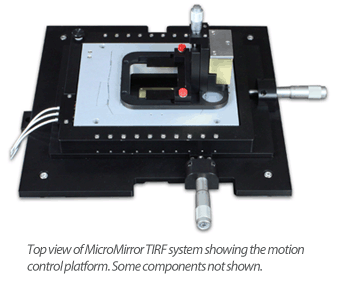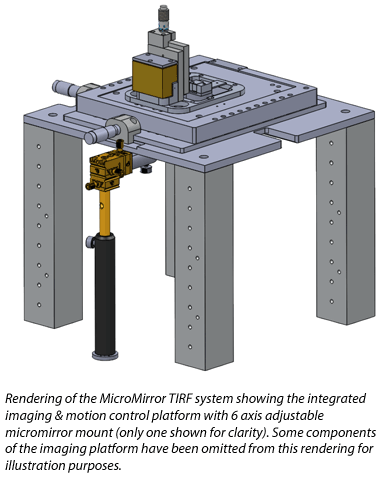News
Nature Protocols Paper on Mad City Labs MicroMirror TIRF SystemNature Protocols has published a paper from researchers at the University of Wisconsin-Madison and Brandeis University about the colocalization single-molecule spectroscopy (CoSMoS) method for studying cellular machines using the MicroMirror TIRF system.
From the abstract: "Design and construction of a scientific microscope often requires a number of custom components and a substantial time commitment. In our protocol, we have streamlined this process by implementation of a commercially available microscopy platform designed to accommodate the optical components necessary for an mmTIRFM. The mmTIRF system eliminates the need for machining custom parts by the end user and facilitates optical alignment."
"Design and construction of a multiwavelength, micromirror total internal reflectance fluorescence microscope". Larson, J. et al. Nature Protocols 9, 2317–2328 (2014)
MicroMirror TIRF
The technique of micro-mirror TIRF (total internal reflection fluorescence) microscopy is the only proven method to study the ordered assembly and function of multi-component biomolecular machines. The Mad City Labs' MicroMirror TIRF system is part of our single molecule imaging instrument portfolio and draws on our expertise with high precision, high stability piezo nanopositioning systems and microscopy solutions.Features
|
Advantages
|
 The MicroMirror TIRF system uses through-the-objective excitation, but replaces the dichroic used in conventional TIRF systems with two broadband micro-mirrors positioned at the back aperture of the objective lens. The elimination of the dichroic mirror leads to superior signal-to-noise ratios and simplifies the introduction of multiple spectral lines to your experiment. Typical biomolecular systems studied using micro-mirror TIRF incorporate 3 or more laser lines which can be difficult to accomodate in conventional dichroic TIRF instruments. Each micro-mirror is mounted to a six axis precision mount allowing the user to make fine adjustments to the optical pathway. The imaging and motion control platform is designed to maximize optical pathway accessibility and flexibility, while also simplifying the optical alignment. A compelling advantage of our MicroMirror TIRF system is the open access to the entry and exit optical pathways. The motion control platform comprises an XY micropositioning platform with an integrated XYZ closed loop piezo nanopositioning system. The XYZ closed loop piezo nanopositioners use proprietary PicoQ® sensors for sub-nanometer precision and high stability.
The MicroMirror TIRF system uses through-the-objective excitation, but replaces the dichroic used in conventional TIRF systems with two broadband micro-mirrors positioned at the back aperture of the objective lens. The elimination of the dichroic mirror leads to superior signal-to-noise ratios and simplifies the introduction of multiple spectral lines to your experiment. Typical biomolecular systems studied using micro-mirror TIRF incorporate 3 or more laser lines which can be difficult to accomodate in conventional dichroic TIRF instruments. Each micro-mirror is mounted to a six axis precision mount allowing the user to make fine adjustments to the optical pathway. The imaging and motion control platform is designed to maximize optical pathway accessibility and flexibility, while also simplifying the optical alignment. A compelling advantage of our MicroMirror TIRF system is the open access to the entry and exit optical pathways. The motion control platform comprises an XY micropositioning platform with an integrated XYZ closed loop piezo nanopositioning system. The XYZ closed loop piezo nanopositioners use proprietary PicoQ® sensors for sub-nanometer precision and high stability.A z-axis micropositioner with integrated sample holder is mounted above the piezo nanopositioning system. Completing our MicroMirror TIRF system is the TIRF Lock feedback control consisting of a QPD sensor, TIRF Lock controller and software. The TIRF Lock module maintains the TIR signal through software feedback to the nanopositioner.
The MicroMirror TIRF system is an enabling technology for advanced study of complex biomolecular interactions. The MicroMirror TIRF is a proven design and offers a simple yet flexible instrument platform for single molecule research.
Technical Specifications - Imaging & Motion Control |
|
| Micropositioning motion | XYZ |
| Ranges of motion (XY) |
25 mm |
| Range of motion (Z) | 10 mm |
| Body Material | Anodized Aluminum |
| Piezo Nanpositioner Motion | XYZ |
| Ranges of motion (XYZ) | 200 μm |
| Resonant Frequency (XYZ) | 350 Hz ±15% |
| Recommended max. load (horizontal)* | 0.5 kg |
| Body Material | Aluminum |
| Controller† | Nano-Drive® |
| Digital Interface | USB 2.0 |
| Analog Input | 0 to 10V |
| Synchronization outputs | TTL (4) |
| Nanopositioner Software† | Nano-Route®3D |
| TIRF Software | GLIMPSE |

Technical Specifications - MicroMirror Mounts |
|
| Micro-Mirror motion | 6 axis |
| Micro-Mirror diameter | 3 mm |
| Mount material | Aluminum |
Technical Specifications - TIRF Lock Feedback |
|
| TIRF-Lock Sensor | Quadrant Photodiode |
| Controller | TIRF Lock |
| Digital interface | USB 2.0 |
| Software | TIRF Lock |
* Larger load requirements should be discussed with our engineering staff. |
|
| † See Software Compatibility, above | |
Compatible Software Packages:




Related Products
- Nano-Cyte
- Nano-Drive
- Nanopositioning Accessories

